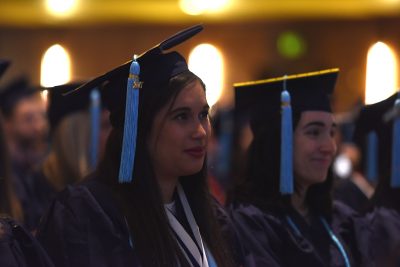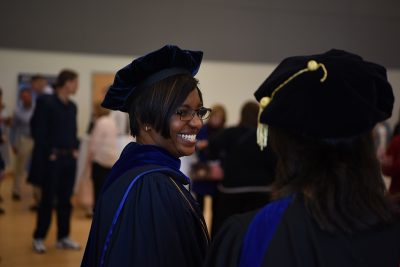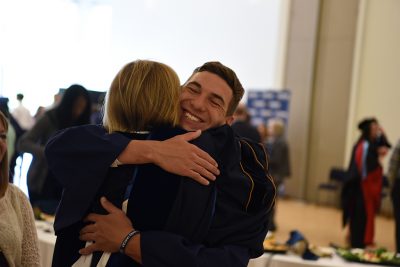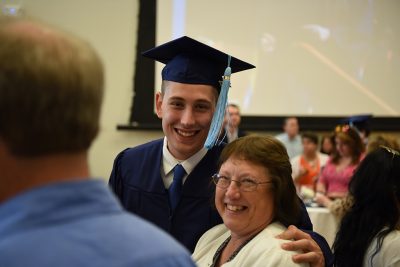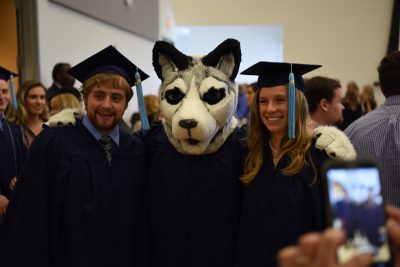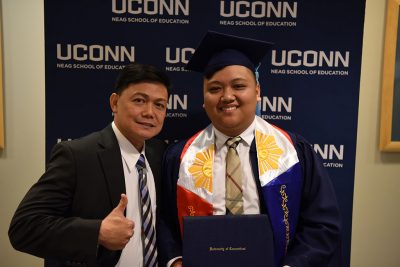UConn Athletics (Neag School recent graduate and incoming fifth-year student Katie Ullinger is featured)
UConn Insider Podcast: Baseball Coach Jim Penders on His Coaching Family
Hartford Courant (Neag School alumnus and UConn baseball coach Jim Penders is profiled)
May 12: Special Education in Connecticut Summit
Class of 2017: Jamie Wisset ’17 (ED), ’18 MA
Editor’s Note: The following excerpt — which features Neag School Class of 2017 music education major Jamie Wisset — originally appeared on UConn Today as part of a larger piece on Commencement 2017.
For UConn’s Class of 2017, it was a year full of surprises. From Donald Trump’s poll-defying victory over Hillary Rodham Clinton to the UConn women’s basketball team’s historic 111-game winning streak, expecting the unexpected almost became standard.
And just when summer-like temperatures teased students with signs of spring one week in March, near blizzard conditions welcomed them the next.
March Madness indeed.
When it comes to exceeding expectations, the Class of 2017 set one record of which it can certainly be proud.
More than 9,000 degrees – both undergraduate and graduate – are being awarded this year, which is the highest number of degrees conferred at UConn in the University’s 136-year history.
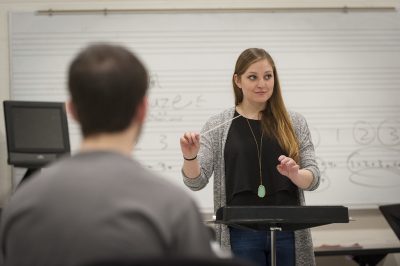
Jamie Wisset
- Music Education Major
- Member of UConn Choir
- Member of the Alpha Epsilon Phi Sororit
- Member of The Chordial
What was a defining moment during your time at UConn?
I don’t think that I have had one singular defining moment while I have been at UConn. Being at UConn has definitely helped to shape me into the person that I am today, but there have been many amazing moments that have had a lasting impact. Among some of these moments was joining my sorority, Alpha Epsilon Phi where I met some of my closest friends and had many leadership opportunities and amazing memories. Another moment was joining the a cappella group, The Chordials. Being a part of the group has given me the chance to perform with many talented people and has helped my confidence grow hugely.
Who have you met here who has already had an impact on your future?
I have met so many amazing girls in my sorority and my a cappella group. Some of these girls have become my roommates and best friends, and I’m sure they will be my future bridesmaids. Many of the teachers in the music program have also helped to shape who I am. They have showed me what it means to be a true leader and I have learned so much from them.
As an active member of the UConn Choir, what did you enjoy most?
My favorite part of being in UConn Choirs was traveling to Ireland and Germany last spring break. It was really fun getting to explore Europe with my friends while also getting to sing in some of the most famous churches in the world. It was also a great bonding experience that made our choir sound even better than it already did.
Where are you headed after graduation?
I am actually in the five-year Music Education Program, so I will be at UConn for another year pursuing a master’s degree in education. After my fifth year, however, I hope to be teaching elementary general music.
What will you miss most about UConn?
There is a lot about UConn that I will miss. I will definitely miss always being on the beautiful campus and all of the opportunities that being here has provided me, but I think that the thing I will miss most is getting to see my friends every day.
West Hartford Teacher of the Year Finalists Announced
we-ha.com (Luis Ramirez, a Neag School alumnus, is a Teacher of the Year finalist for West Hartford)
2017 Brings Highest Amount of Degrees Conferred in UConn History
The Daily Campus (Neag School’s Commencement speaker Lynda Mullaly Hunt was mentioned in this article)
New Study Highlights High Quality Career and Technical Education
MassBudget (A new research report by Neag School’s Shaun Dougherty was covered)
Neag School Celebrates 2017 Commencement Weekend
The Neag School’s Class of 2017 graduates and their guests joined faculty, staff, and administrators this past weekend in celebration of Commencement Weekend, held on the UConn Storrs campus.
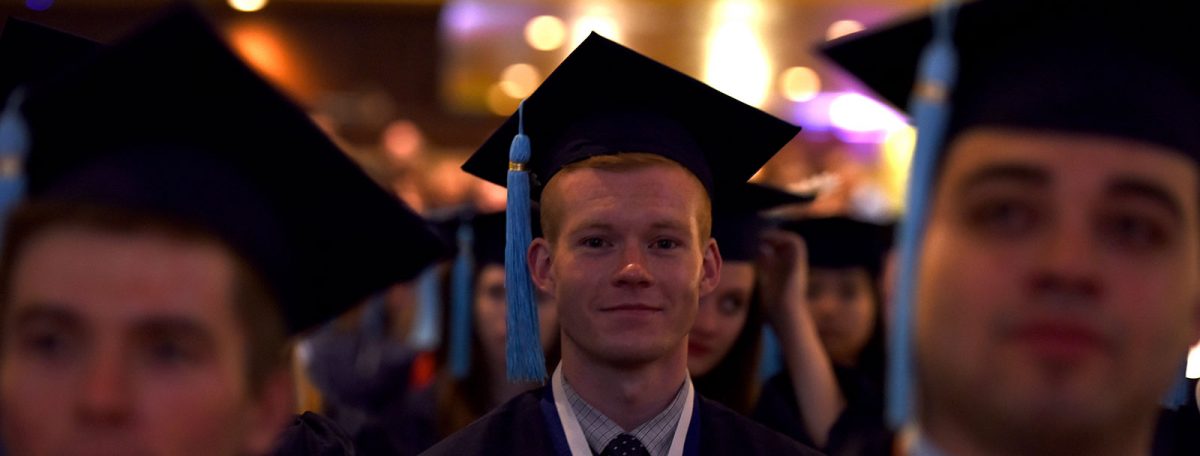
The Neag School’s Undergraduate Commencement Ceremony, held Sunday, May 7, featured surprise visits from Jonathans XIII and XIV, who accompanied the nearly 150 graduates in their processional to the Jorgensen Center for the Performing Arts.
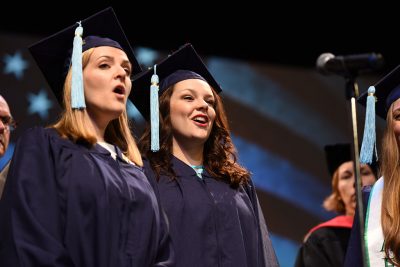
Five Neag School music education majors and Class of 2017 graduates — Noah Fields, Victoria Ioppolo, Alyssa Venora, and Jamie Wisset — sang the national anthem.
Best-selling children’s author Lynda Mullaly Hunt ’88 (ED), ’97 MA, a two-time alumna of the Neag School, delivered the Undergraduate Commencement address. She outlined for graduates from the Neag School’s sport management and teacher education undergraduate programs eight ways in which UConn basketball mirrors life.
“Be brave. You have nothing to gain by playing small,” she said during her remarks. “Quiet confidence — not arrogance — is something people will remember about you for a long time.” She received a warm standing ovation from the audience at Jorgensen.
During the Undergraduate Commencement Ceremony, the School also showcased two videos — one featuring alumni, students, and faculty sharing their Neag School experiences, and a second video in which graduating seniors offered personal messages of gratitude to their families, faculty mentors, and friends.
Congratulations,
Neag School Class of 2017!Find our Commencement video highlights, photo albums, and more here.
Graduates and their guests celebrated afterward during a reception held at the Student Union, where they enjoyed a photo booth and photo opportunities with UConn mascot Jonathan the Husky and Dean Gladis Kersaint.
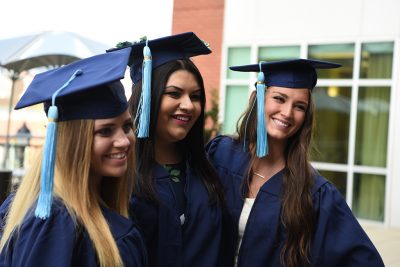
On Saturday, May 6, Neag School master’s and sixth-year graduates attended a pre-ceremony reception at the Student Union (see photos), followed by the Graduate School Commencement ceremony at Gampel Pavilion, where UConn alum and political analyst Stuart Rothenberg ’72 MA, ’77 Ph.D., delivered the Commencement address.
Graduates from the Neag School doctoral program will celebrate on Monday evening at a pre-ceremony reception held at the Alumni House, followed by the Commencement ceremony at Jorgensen.
In total, more than 9,000 undergraduate and graduate students were awarded UConn degrees this year.
Check out video highlights, photo albums, archived video, and more from the Neag School 2017 Commencement Weekend celebration here.
Heather McGhee: Paving the Way For a More Equitable America
WNPR (Audio – 27:00 Dorothea Anagnostopoulos is interviewed about the importance of covering racial issues in teacher preparation programs)
Motivation Boost for German Teachers in Connecticut
Fulbright Kommission (Neag School’s partnership with German teachers is featured)
